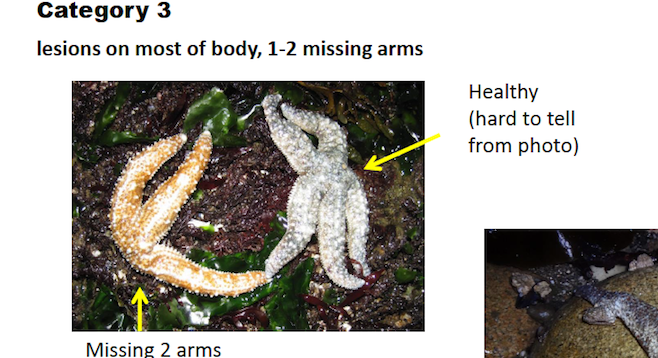 Facebook
Facebook
 X
X
 Instagram
Instagram
 TikTok
TikTok
 Youtube
Youtube

If you've spotted a severed arm or leg along the shoreline, take note. Something is mutilating sea stars, and extra eyes are urgently needed to solve the mystery.
“Sea star wasting syndrome,” a disease that twists and melts their limbs, has swept south after the outbreak was reported last June in the state of Washington.
In December, afflicted sea stars were found off Point Loma. The latest sampling uncovers the disease at new locations there, including south Point Loma in February, New Hope Rock in March, and at north Coronado Island in April.
“The die-off is pretty extensive and getting worse all the time,” says Pete Raimondi, a researcher at the University of California Santa Cruz who is leading efforts to track the disease, working with scientists in San Diego and other areas.
“Our teams are out as we speak, and the reports are bad.” They suspect a bacterial or viral pathogen but still don’t know what’s causing the largest known die-off of sea stars.
The disease, which affects at least 15 species, could strongly alter tide-pool ecosystems, where sea stars prey heavily on mussels. Long-term monitoring by the Multi-Agency Rocky Intertidal Network (MARINe) and other groups has helped researchers compare distributions of starfish species along the West Coast.
Now, even more documentation is needed, and anyone can pitch in. Citizen monitors are really important, Raimondi says. The University of Santa Cruz is enlisting citizens to report all sea star sightings to their citizen science website: seastarwasting.org.
MARINe has a tracking log that can be downloaded so researchers, divers, and members of the public can report their observations. People are urged to fill out a log “even if you only find healthy sea stars or no sea stars,” Raimondi says. “This information is just as valuable as observations of diseased individuals.”
The website is regularly updated with the latest reports and mapping. So far, the large die-off that’s occurred in other counties hasn’t hit here. But witnesses may find more than anyone knows.
With an El Niño weather pattern expected to arrive next fall, Raimondi’s forecast for the sea stars’ health is not good: a big outbreak of wasting disease occurred during the last El Niño year, possibly owing to the warm water.
“If it is like the past [El Niño year], the wasting will be much worse,” Raimondi says.


If you've spotted a severed arm or leg along the shoreline, take note. Something is mutilating sea stars, and extra eyes are urgently needed to solve the mystery.
“Sea star wasting syndrome,” a disease that twists and melts their limbs, has swept south after the outbreak was reported last June in the state of Washington.
In December, afflicted sea stars were found off Point Loma. The latest sampling uncovers the disease at new locations there, including south Point Loma in February, New Hope Rock in March, and at north Coronado Island in April.
“The die-off is pretty extensive and getting worse all the time,” says Pete Raimondi, a researcher at the University of California Santa Cruz who is leading efforts to track the disease, working with scientists in San Diego and other areas.
“Our teams are out as we speak, and the reports are bad.” They suspect a bacterial or viral pathogen but still don’t know what’s causing the largest known die-off of sea stars.
The disease, which affects at least 15 species, could strongly alter tide-pool ecosystems, where sea stars prey heavily on mussels. Long-term monitoring by the Multi-Agency Rocky Intertidal Network (MARINe) and other groups has helped researchers compare distributions of starfish species along the West Coast.
Now, even more documentation is needed, and anyone can pitch in. Citizen monitors are really important, Raimondi says. The University of Santa Cruz is enlisting citizens to report all sea star sightings to their citizen science website: seastarwasting.org.
MARINe has a tracking log that can be downloaded so researchers, divers, and members of the public can report their observations. People are urged to fill out a log “even if you only find healthy sea stars or no sea stars,” Raimondi says. “This information is just as valuable as observations of diseased individuals.”
The website is regularly updated with the latest reports and mapping. So far, the large die-off that’s occurred in other counties hasn’t hit here. But witnesses may find more than anyone knows.
With an El Niño weather pattern expected to arrive next fall, Raimondi’s forecast for the sea stars’ health is not good: a big outbreak of wasting disease occurred during the last El Niño year, possibly owing to the warm water.
“If it is like the past [El Niño year], the wasting will be much worse,” Raimondi says.
Comments